Mammalian Fauna and Conservational Issues of the Baraiyadhala National Park in Chittagong, Bangladesh ()
1. Introduction
Mammals are the most diverse group of wildlife. They show an amazing diversity of species, forms, ecologies, physiologies, life histories and behaviors (Jones & Safi, 2011) . They provide numerous benefits to us by both directly (e.g., important protein source for many cultures and rural people) and indirectly (e.g., they play crucial role in maintaining balanced ecosystems as prey and/or hunters, pollinators, seed dispersal, etc). The zoogeographical position of Bangladesh in between the Himalayan, Indian Peninsulas and Endo-Burma Sub-regions of Indo- Malayan realm has supported rich mammalian fauna. Bangladesh is represented by 124 species of mammals belonging to 13 Order and 36 Family (Khan, 2010) , which is nearly one-fourth of the Indian mammalian fauna (Ahsan & Chowdhury, 2008) .
As part of the biodiversity conservation effort, there are 37 protected areas (PAs) in the country of which 17 are National Parks (NPs) and 20 Wildlife Sanctuaries (WSs) (www.bforest.gov.bd). But extensive works on mammalian fauna not only in these PAs but also in any area of Bangladesh are limited. Previously most of the works were accomplished on a single species of an area (e.g., Capped Langur: Islam, 1979 ; Asian Elephant: Zabed, 1992 and Western Hoolock Gibbon: Ahsan, 1994 ); on a specific group, bats (Ahmed, 1975), primates (Ahsan, 1984); wildlife of a specific area, e.g., Satchari Reserve Forest now National Park (Feeroz, 2003) and biodiversity on a specific area, e.g., Rema-Kalenga WS (Feeroz et al., 2011) , Dudpukuria-Dhopachari WS (Feeroz et al., 2012) , and Teknaf WS (Feeroz, 2013) . But published/unpublished works neither exclusively on mammals nor on other groups of wildlife of the Baraiyadhala National Park (BNP) are available. So an attempt was taken to study the mammalian fauna of the BNP along the selected transect lines.
Line transect method is mostly used to estimate population of both medium and large-sized animals in large area (cf. Sheng & Xu, 1992 ). Community, in biology, is a group of interdependent organisms inhabiting the same region and interacting with each other. Line transect is an effective technique to sample an area in which biologists record data regarding communities in an ecosystem. It is based on the theory of walking along a predetermined route at a fixed speed to record the wildlife on or near the line. This method requires great care, and any line transect should be designed in such a way that basic assumptions are not violated.
2. Materials and Methods
2.1. Study Area
BNP (Map 1), formerly a part of the Reserved Forest of Chittagong North Forest Division, was designated a protected area on 6 April 2010 through a Gazzette Notification (PaBaMa/Bon Sha-2/02/National Park/10/2010/ 210) under the Provisions of Article 23(1) of the Bangladesh Wildlife (Preservation) (Amendment) Act, 1974 (which has now been altered by Wildlife [Conservation and Security] Act, 2012). The Park is located at 172 km southeast of Dhaka (the capital of Bangladesh) and 45 km northwest of Chittagong City (22˚40.489'N and 22˚48'N and 90˚40'E and 91˚55.979'E). It covers the area of Sitakunda and Mirsharai Upazilas and situated about 1.5 km west of the Dhaka-Chittagong Highway and 0.5 km west of Dhaka-Chittagong Railway Line. The park encompasses 2933.61 ha of land area under the Baraiyadhala Forest Range Office. The Park comprises three blocks: Baraiyadhala and Wahidpur Blocks under Baraiyadhala Forest Beat, and Kunderhat Block under Bartakia Forest Beat.
The BNP supports the following types of forest: tropical mixed-evergreen; tropical wet evergreen; tropical moist deciduous; bamboo thickets; and artificial or plantation. The topography of the Park is very undulating and covers with a linear hill range (elongation north to south reaching an altitude up to 350 m). Hilly topography constitutes with high (152 to 365 m), medium high (76 to 152 m) and lower hills (15 to 76 m). The park area is Mio-Pliocene in origin where 3 representative geological series (Surma, Tipam and Dhupitila) are found and the soils are yellowish brown to strong brown (high hills), strong brown to yellowish red (low hills) (Hassan, 1994) , and brown colored foot hill (piedmont) soils are usual, slightly acid or neutral, with high base status (Champion et al., 1965) . The park is interspersed by valleys, gullies and streams. Most of the streams are seasonal and dry up during off-monsoon season. The park area enjoys a moist tropical maritime climate and rainfall is frequent and heavy during the monsoon season (May to October) ranging between 115.2 mm to 561.1 mm total rainfall 1891 mm). The average maximum annual temperature was 31.50˚C and the minimum 20.67˚C, whereas the average maximum and minimum range of relative humidity were respectively 99.10% and 49.86% (Sitakunda Agro-met. Office, 2012-13).
Wildlife habitats of the Park are divided into two major categories for evaluating the habitat preference of the species: 1) aquatic and 2) terrestrial. Aquatic habitat is characterized several subcategories such as streams/ creeks, ponds, ditches and canals, and the terrestrial one by forests, bushes/scrubs, road side places, human habitations, marshy lands, cultivated fields, grass/fallow lands, under logs/rocks, dry stream bed, trees/tree holes, open woods, caves/crevices, forest edges and water edges.
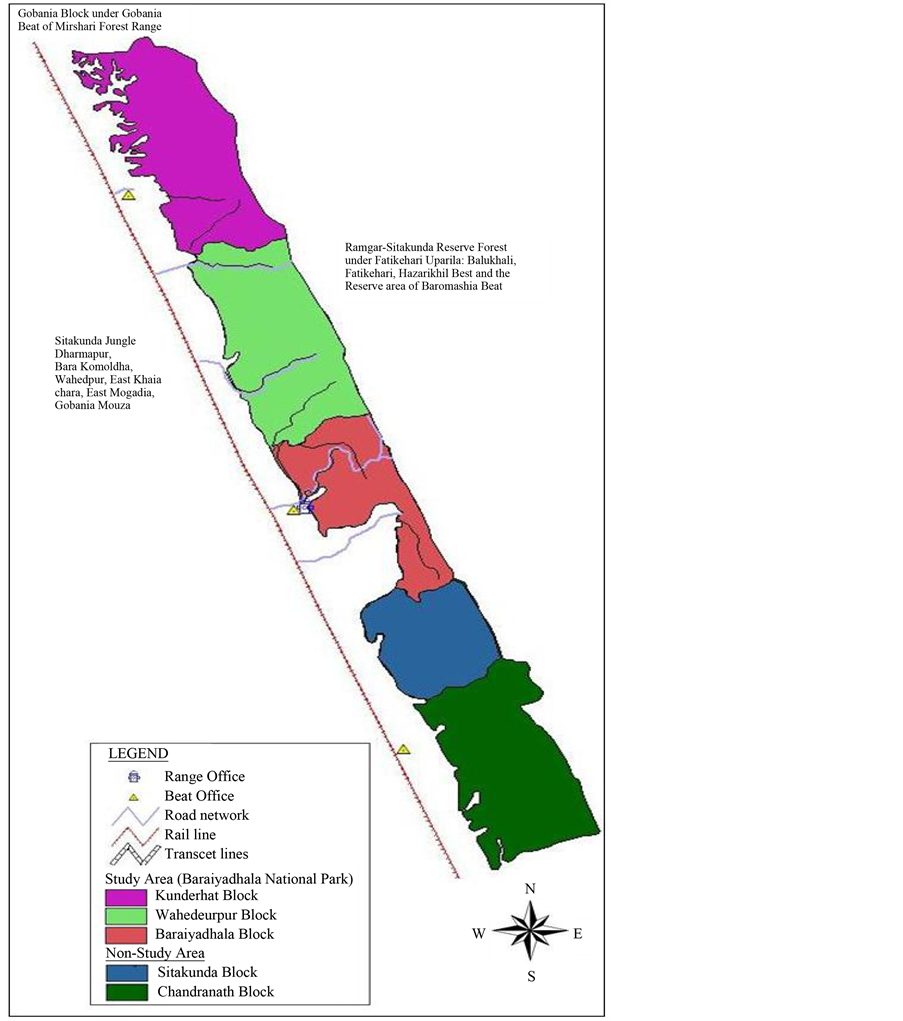
Map 1. Baraiyadhala forest range (Study area: baraiyadhala national park).
2.2. Data Collection
Fieldwork was carried out at the BNP in Chittagong, Bangladesh from August 2012 to July 2013. Monthly minimum three and maximum five days were spent in the field during the study period. The observations were usually started early in the morning specifically from after half an hour of sunrise and continued to 1100 h, and in the afternoon session from 1500 h to dusk. Three to four hours were spent during mid-evening to early night to observe nocturnal species and on an average of 10 hrs were spent in a day.
Data were collected through direct field observations along the selected transect lines. Line transect method (LTM) is used to estimate of both medium and large-sized animals in large area (Sheng & Xu, 1992) . In this method, the observer slowly walks on a straight line and counts the objects from both sides. Nine transect lines were established to observe wildlife and their different activities. Each transect was about one kilometer long and 10 m wide on both sides. It was not easy to observe nocturnal and other shy animals in the field. So the nocturnal animals like bat, wild boar, jackal and others were recorded and identified by the using of droppings and/or foot prints. Sometimes vocal sounds of animals (e.g., barking deer, jackal, etc.) also helped as important cue to identify the species. Color and pattern of hair, size and shape of body assisted to identify mammals, more specifically primates.
Animal occurrence was also confirmed sporadically through interviewing local people, forest workers, farmers, fire wood collectors and elderly people (who were over 40 years old) to gather important information about the past and present status of wild mammals. Usually photographs were shown to them to confirm identification of this wildlife. The recorded mammalian species in the BNP were sorted into taxonomic orders following Ahmed et al. (2009) .
2.3. Data Analysis
The local status of birds was assessed based on relative occurrence following (Khan, 1982) : 1) very common- species seen 80% to 100% of the field visits and in good number; 2) common-species seen during 50% - 79% of the visits; 3) fairly common/uncommon species seen during 20% - 49% of the visits; and 4) rare-species observed less than 19% of the visits in very small number.
There are several formulas in estimating population density from line transect data. However, according to Harris and Burnham (2002) , LTM can produce unreliable results, if critical assumptions are violated in the field, and/or if inappropriate mathematical analyses are applied afterwards. The following formula has preferably been applied by wildlife scientists (e.g., Sheng & Xu, 1992; State Wildlife Protection Office, 1995; Harris & Burnham, 2002; Kabir, 2012 ) for population density:

where,
D = estimated density of animals
n = total number of animals
s = mean group size (if present)
L = length of transect line(s)
W = mean perpendicular distance of animals (naïvely transect width)
The official notified area of the Park is 2933.61 ha but the actual wildlife habitable area will be less due to forest fragmentation by roads, occupation of forest edges by local people to expand cultivated land and human settlement. Besides, there is an establishment of a tribal colony (Kanchanpur Purba Tripura Para) at Kunderhat Block within the forest area. So it seems to be the actual wildlife habitable area will be about 2700 ha. Mammals are very shy animals and they are found mainly in bushy and forested areas, and the probability of seeing large mammals at forest edge is minimal. So, it seems to be 75% (i.e., about 2000 ha [20 km2]) area of the Park supports habitable area for mammals.
3. Results and Discussion
3.1. Species Composition and Population Density
Twenty nine mammalian species were recorded under 9 Order, 17 Family and 26 Genera (Appendix 1) from the BNP through direct field observations along the transect lines and also from the information of the forest workers and local people. These were primates, rodents, lagomorph, chiropterans, manid, carnivores and ungulates; of which rodents represented the highest number of species (10 spp.; 34.48%). The number of species counted in the LTM varied monthly from 9 to 22 (mean 15.67) during the study period (Figure 1). On the other hand, the total number of counted mammalian members also varied monthly from 52 to 132 (Figure 1). The estimated total population in the surveyed area was 1033 (mean 86.08 in each month) and the overall population density was 239.12/km2 (4782.4 in their habitable area [20 km2]). Among the species, the Irrawardy Squirrel (Callosciurus pygerythrus) represented the highest number (488, mean 40.67 in each month) and its density was 112.97/km2 [2259.44 in their habitable area]), and several species such as brush-tailed porcupine (Atherurus macrourus), black-beared tomb bat (Taphozous melanopogon), and Indian pangolin (Manis crassicaudata) symbolized the
![]()
Figure 1. Monthly variation of mammalian species composition observed in the BNP.
lowest (1 individual, mean 0.08, and density 0.22/km2 and 4.4/20 km2).
Twenty nine species of mammals (i.e., 23.38% of country’s total species of 124 [Khan, 2010] ) were documented in the BNP of which twenty (71.42%) species were recorded from direct field observations and the rest (Appendix 1) from the reports of locals through interviewing them showing photographs from the book Ahmed et al. (2009) .
According to the local people Asiatic elephant (Elephas maximus), leopard (Panthera pardous), Bengal tiger (P. tigris) and Asiatic black bear (Ursus thibetanus) have totally been exterminated from this area and the reported 9 species are occasionally seen (Appendix 1). Furthermore, some people also suspect the presence of common otter (Lutra lutra).
Feeroz et al. (2012) reported a total of 50 mammalian species from Dudpukuria-Dhopachari Wildlife Sanctuary (DDWS), which is much more than that of the present study. The predictions for this difference are: 1) DDWS is over 1.5 times larger than the BNP; 2) DDWS is situated at very remote area therefore human disturbances and poachers’ activity is comparatively less than the BNP, and 3) intact situation of wildlife habitat in the DDWS.
Ahsan and Chowdhury (2008) cited 27 mammalian species from the Chittagong University Campus (CUC) which is nearly the same number (29) of species in compare to the BNP. Though the area of BNP is larger than the CUC but the habitats of these two areas are very similar. Muridae appears to be the largest family in the study area (having 4 genera and 6 species) and several had single species (Appendix 1).
Ahsan (1984) first confirmed the presence of Assamese Macaque (Macaca assamensis) at Patharia Hill in Sylhet. After that there was no direct evidence of the occurrence of the species elsewhere the country. However, some workers predict their presence in Chittagong and the Chittagong Hill Tracts. And the present study has confirmed the presence of Assamese Macaque ( Plate 1 ) at Featta Daffa Hill in the BNP.
3.2. Monthly and Seasonal Variation
The maximum number of species, 22 (75.86%) of 29 were recorded in April 2013 and their total population was 132. The lowest number of species (9 i.e., 31.03%) and population (52 i.e., 5.08%) were in January 2013 (Figure 1). Seasonal variation was not prominently marked during the study period. As mammals are not seen easily and also about one-third of the species were reported, the variation in the number of species and population occurrence was somewhat expectable.
3.3. Habitat Used
The recorded mammalian species of the study area were mainly two types: semi-aquatic and terrestrial. The semi-aquatic one was only a single species (3.44%) Crab-eating Mongoose (Herpestes urva) was found both in aquatic and terrestrial habitats, and the rest (28 spp.) were terrestrial. The semi-aquatic species was often found
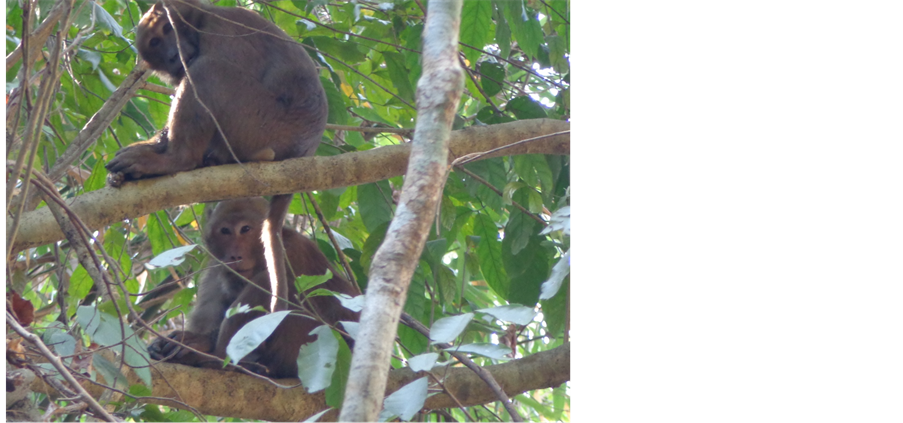
Plate 1. Assamese macaque (Macaca assamensis).
in and around the stream water (locally called chara) in study area. Semi-aquatic mammals occupy the intermediate position between terrestrial and aquatic mammals (Fish & Baudinette, 1999) ; more specifically can be said semi-aquatic mammals are those that are primarily terrestrial but that spend a large amount of time under water, either as part of their life cycle or as an essential behavior (e.g., feeding) (https://en.wikipedia.org/wiki/List_of_semiaquatic_tetrapods).
Among the terrestrial mammals, there were also 3 arboreal species (Rhesus macaque [Macaca mulatta], capped langur [Trachypithecus pileatus] and Irrawardy squirrel [Callosciurus pygerythrus]) and 5 aerial species (Indian flying fox [Pteropus giganteus], fulvous fruit bat [Rousettus leschenaulti], Indian false vampire [Megaderma lyra], greater mouse-tailed bat [Rhinopoma macrophyllum] and black-bearded tomb bat [Taphozous melanopogon]), and the rest used more than one environment of terrestrial habitat.
Fragmented forest patches, rapid degradation of the upper canopy and discontinuous canopy attachment are the severe threat to the monkeys in the study area. Conversion of dense bushy habitat into planted forest and physically human disturbances have accelerated the Asiatic Serow (Capricornis sumatraensis) to be a critically threatened group in the study area.
3.4. Feeding Habit
Mammals are diverse group of animals in feeding behavior especially food habits of carnivores are central to the ecological niches they occupy, play an important role in explaining their social systems, behavior, and factors affecting population density, and may also have important implicating in the life histories of their prey (Mills, 1992) . Mammals occupied a wide spectrum of feeding niches in the study area. In most terrestrial and some aquatic communities, carnivorous mammals were the top predators. Herbaceous mammals were the primary feeders in the study area. Of the recorded mammalian species (29) their feeding modes were: 1 (3.44%) seed-eater, 3 (10.34%) frugivores, 5 (17.24%) herbivores, 6 (20.68%) carnivores, 4 (13.79%) insectivores, 3 (10.34%) mixed feeders and 7 (24.13%) omnivores. Feeroz et al. (2012) reported 50 species of mammals from DDWS of which the highest mammals (36%) were carnivores followed by frugivores (22%), opportunists (18%), both herbivore and insectivores (10% each) and folivores (4%).
3.5. Local Status
Among a total of 29 mammalian members, 1 (3.44%) was very common 6 (20.68%) common, 7 (24.13%) fairly common and 15 (51.72%) were rare (Appendix 1).
The present work has been compared to other similar studies in country level ( Khan, 1982; Sarker & Sarker, 1988; Asmat & Hannan, 2007 compiled in the Appendix 1) and elsewhere in Bangladesh on wildlife (e.g., Feeroz et al., 2011, 2012; Feeroz, 2013 ). The commonest species of the mammalian fauna in the study area was Irrawaddy Squirrel followed by house mouse, barking deer and Indian wild boar.
3.6. National Conservation Status (IUCN Bangladesh, 2000a, b)
Among 29 species of mammals 3 (10.34%) were Critically Endangered, 7 (24.13%) Endangered, 3 (10.34%) Vulnerable, 6 (20.68%) Data Deficient and remaining 10 (34.48%) species were Not Threatened. From these figures, it is clear that most of the members, 13 (44.83%), were calculated as Threatened (i.e., critically endangered, endangered and Vulnerable) followed by Not Threatened (NO) and Data Deficient (DD) (Appendix 1). Comparing this finding to the country’ level (43 spp.) (IUCN, 2000a), it is clear that the study area supports 30.23% of the threatened mammalian species of Bangladesh. These indicate that the wild habitat of the Park is rich and still provides the key requirements for the conservation of these threatened species.
4. Conservational Issues
4.1. Problems
The conservation of natural ecosystem has long been on the agenda of institutions concerned with biodiversity (Torri, 2011) , because most of world’s species live only in the wild, so preserving habitats that contain biological communities is the effective way to preserve biological diversity (Primack, 1993) . Establishing legally designated “protected areas” in and around forests is an advanced and wide spread measure for conserving nature and natural resources around the world (Mukul, 2007), which cover 11.5% of the earth’s land surface (Chape et al., 2003) and only 5% of the tropical forest area (Dupuy et al., 1999) . Like other countries of the world, Bangladesh also realizes the continued depletion of forest resources hence started to establish protected areas (PAs) in her natural forests since 1960. The first declaration of PA (Modhupur National Park, 1962 and extended 1982) was under the provision of the Forest Act, 1927, which got the momentum after the enactment of the Bangladesh Wildlife (Preservation) Order, 1973 (Chowdhury, 2010) and signing of the Rio Convention in 1992. There were only 3 PAs (Modhupur NP, Bhawal NP and Himchari NP) before 1992 and now it has increased to 37 (17 NPs. and 20 WSs) (www.bforest.gov.bd). As part of the going process of establishing PAs, the three (Kunderhat, Wahedpur and Baraiyadhala) of five blocks under Baraiyadhala Forest Range (Map 1), Sitakunda was declared as Baraiyadhala National Park in 6 April 2010. It is true that establishing PAs are essential measures to halt and/or completely stop habitat loss, illegal poaching, over exploitation of resources and so on. However, some activities were also observed during the study period which is threats for the biodiversity of this park as follows:
v Though the incidence of forest fires in Bangladesh is considered to be insignificant (Srivastava et al., 2008) , this forest zone is seriously prone to fires which set deliberately by local people for fuel wood. The Baraiyadhala Forest Range Officer, Mr. Aurune Kumar, said that he has ever never seen most firing zone before it in his 30 years service life. Periodically or controlled fire may help to create a variety of succesional stages, but here more frequent fire during the dry season is common and causes soil erosion during heavy rain, and eliminate both regenerated and planted seedlings, and native animal species.
v Earlier forest officers patronized to establish a tribal colony, Kanchonpur Purba Tripura Para, at Kunderhat block under Bartakeya beat to exploit them as cheap forest workers ( Plate 2(a) ). Several interviewees complained that they and other tribal persons from elsewhere sporadically search the forest for tortoises, frogs (e.g., bull frog) and yam. Besides some of them rear wild boar to sell which may chance/influence them poaching animals from the forests ( Plate 2(d) ).
v Most of the forest edges are occupied by landless people from elsewhere the country where they have built houses and farms. They not only hamper the ecotone system but also often enter the forest and cut down trees, immature poles, especially bamboos to sell them in the market ( Plate 2(c) ). As result wildlife that dependent on bamboo thickets move elsewhere and/or die out. Some local people opportunistically hunt barking deer and Asiatic Serow. All most all interviewees have confirmed the presence of Asiatic serow in the park and some of them also complained that an Asiatic serow slaughtered by some people and one of them also captured this scenery in his mobile. We have tried to collect this video clip but failed. It is also a tradition to collect medicinal plants or its part from the forest by local Kabiraj (traditional doctor). Cycas (Bon-khejur [Cycas pectinatus]), a notable plant species that naturally occur only in two areas of Bangladesh of which one is this park but its population has been passing a critical condition because the leaves of it are collected recklessly by local people and sell them as ornamental elements to decorate the marriage ceremony
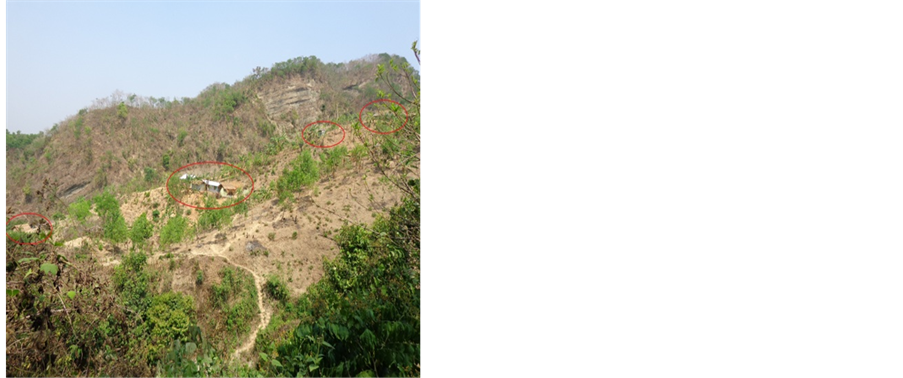
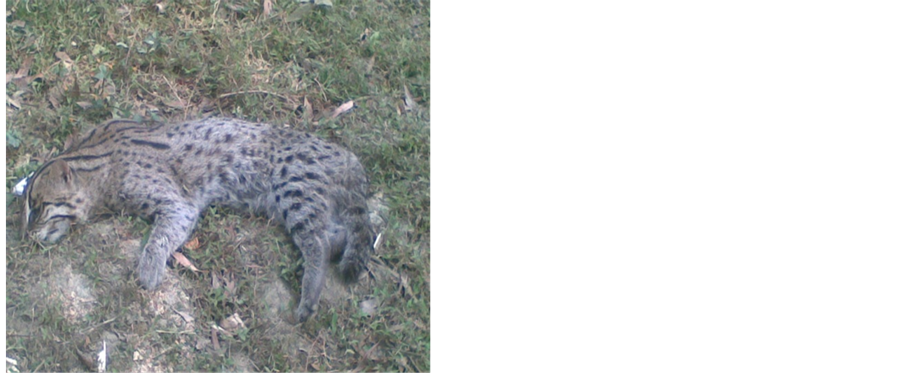
(a) (b)
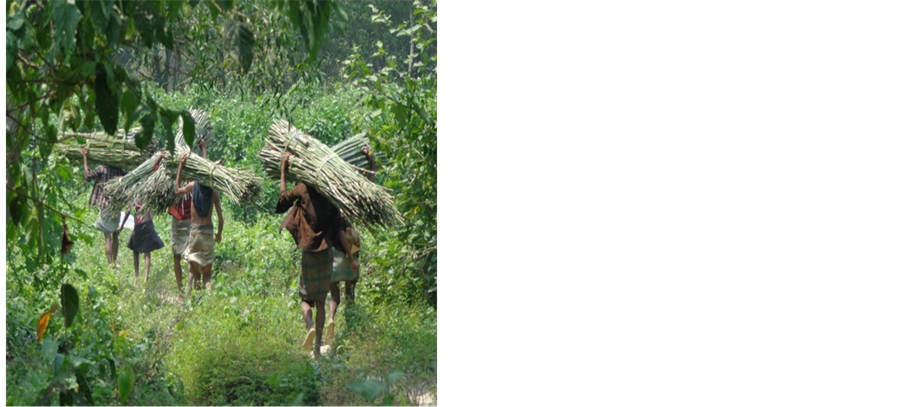
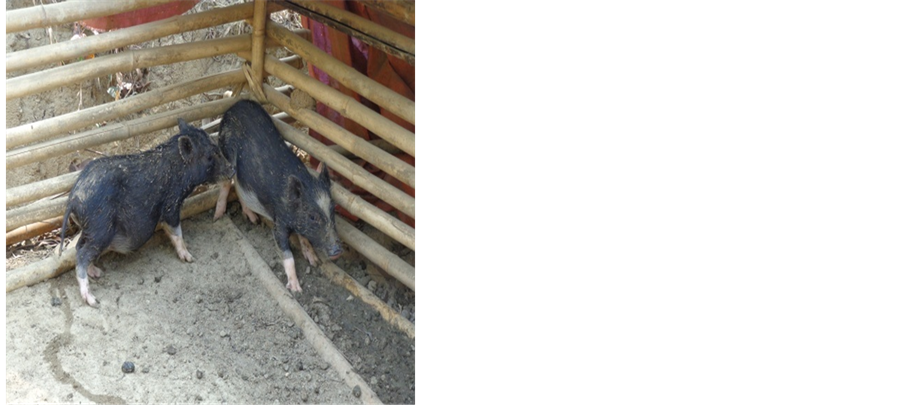
(c) (d)
Plate 2. Some threats of the BNP. (a) Partial view of tribal colony; (b) Fishing Cat killed by locals using poisonous bait; (c) Local people collecting bamboos; (d) Rearing of Wild Boar.
and others programs. Furthermore, these people often use poisonous bait to kill carnivore mammals for conserving their poultry and livestock. During the study period, a dead body of Fishing Cat was found nearby forest edge that ate poisonous food baited by locals ( Plate 2(b) ).
v Introduction of livestock for grazing is very frequent in this forest causing destruction of under growth and ultimately interfering with forest regeneration.
v Four water creeks (chara) and few ditches exist during dry season. Further, most of the ditches remain polluted by the rotting of dead leaves. Compare to the total area, these water supplies is insufficient. Again, most of the forest nurseries were established center to the creeks where the entrants are more hence the animals can’t freely use these water bodies for drinking. Normally many of the wildlife need water and its demand increases in summer especially for herbivores (e.g., deer and elephant). As these fewer water bodies are selected by wildlife, it is trouble-free for hunters to hunt these animals.
4.2. Recommendations/Management
v Translocate and rehabilitate those people who live in and on forest edge elsewhere the country.
v Ensure adequate staff with facilities and better access to modern technologies and equipment (Mukul et al., 2008) .
v Safe guarding boundaries are essential. Guarding post should be located at definite distance intervals according to need along the border with 2 - 3 guards in each post to prevent poaching and other intruders.
v Give priority of guaranteed access to resources by which controlling excess entrants in forest and also frequent fires.
v Improve food supply to the wildlife by planting fodder species through enrichment plantation and ensure drinking water hole for wildlife.
v Developing poverty reduction strategies in areas around the National Park through developing alternative income generating (AIG) activities and providing micro-credit facilities to rural people (Mukul et al., 2008) .
v Precisely apply legal action (Law enforcement).
v Increase awareness of the people around the park through workshops, film screenings, photographic displays, folk songs and staged drama events at regular intervals to educate them to understand the effect of forest fire, destruction of forests and importance of wildlife.
Acknowledgements
We express our sincere thanks to Professor Dr. Md. Ismail Miah, Chairman, Department of Zoology, University of Chittagong, Chittagong, for providing all facilities to conduct the work. We are indebted and thankful to Mizanur Rahman, Alamgir Hossain, and Mamun for their helpful co-operation during the study period.
Appendix 1
Systematic List of the Recorded Species and Their Status in the Study Area Compared to the Early Records and IUCN Bangladesh
Note: *Reported Species, ARK―Ali Reza Khan (1982) , C―Common, CR―Critically Endangered, DD―Data Deficient, DF―Deciduous Forest, E―East, EN―Endangered, FC―Fairly Common, LC―Least Concern, LR―Lower Risk, LR/lc―Lower Risk/least concern, LR/nt―Lower Risk/ near threatened, MEF―Mixed Evergreen Forest, NO―Not Threatened, O―Occasional, r―Rare or Few, SB―Sundarbans Mangrove Forest, SE― Southeast, SS― Sarker and Sarker (1988)